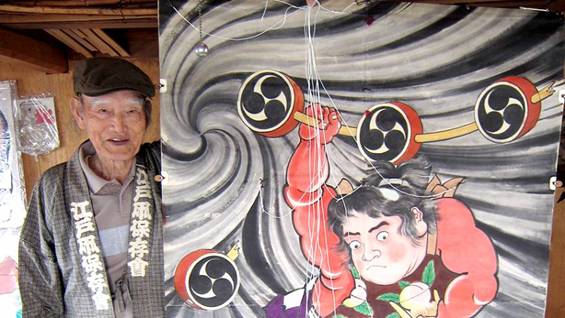Resource: The Japan Times
http://www.japantimes.co.jp/life/2013/03/27/people/kite-artist-tetsuya-kishida/#.UVVGAldjh_M

Japanese kite artist Tetsuya Kishida, 89, has been creating and flying kites since the age of 6. He used to be a salesman for the steel industry and he later sold bonsai. In his late 40s, he finally turned his hobby of painting kites into a profession. His artistic repertoire is inspired by images from musha-e, a genre of ukiyo-e (floating world images) that depicts samurai in battle scenes. He also paints Japanese heroes the from the Heian Period (794-1185) to the Edo Period (1603-1867), including kabuki stars. Although kite painting is his greatest passion, flying them comes a close second. Five days a week, weather permitting, he goes out with four similarly minded friends, and they fly their kites.
To lie on the grass and gaze at a beautiful kite above is the best feeling in the world. I rarely have this pleasure as I’m usually chasing my kites. That’s wonderful, too. I make Edo-style kites, which are stabilized by 14 to 17 lines that are connected to the sides of the picture and spaced at regular intervals. With these lines we balance the image so people on the ground can see it well. On the top, we add an extra bamboo pole that vibrates to create a wonderful buzzing sound as the wind carries the kite. This is what makes an Edo kite special. It lets people know that there is a kite above them. “Look up!”
Kites are a perfect way to study history. Kites are invested with prayers for children to grow into healthy and strong adults. This is why I paint strong characters. For example, Momotaro is a cute but powerful hero in Japanese folklore. When depicted as a baby, he is shown with peaches because he was found floating down the river in a giant peach. On a kite, however, he is depicted fighting demons, helped by his friends a dog and a monkey.
Kites come alive in the sky, and that’s how they bring happiness to all who see them. Kites awaken the carefree child in us. I’m often asked to paint my images on canvas so people can hang them in their homes as paintings. I really don’t like this idea because the whole purpose of a kite is for it to dance in the air and be seen by many, not to be caged in a room.
Don’t argue! I never do. I ignore the bad guys. Getting angry never gets positive results.
Every country must accept and follow international law. When Japan surrendered on Aug.15, 1945, I was a pilot at an air station in what is now North Korea. The Soviet army entered our camp. We were ordered by our commander not to fight as the war was over. We peacefully boarded the Soviet ships as we thought we were returning to Japan. We were packed in like sardines but we were happy, nevertheless. But when the ship entered port, we were in Nakhodka, a Russian city near Vladivostok. Imagine our shock! Next we were transported to Siberia. It was -45 degrees when we arrived and we had to walk for three days, about 100 km, to reach our camp. Many Japanese died on the way. For the next two and a half years I was in a Siberian gulag, working in horrible conditions. I’m lucky because I survived. Many of the 600,000 Japanese POWs did not. If the Soviets had followed international law, there wouldn’t have been suffering like that.
Enjoy life and don’t worry if you don’t fit the mold people want you to be in. Today’s rules will be broken tomorrow, anyhow.
Thanks to my spouse and her bento (boxed lunch) making, we got married. Soldiers like me had no idea about women. Hard to believe but true. We were drafted into the army as teenagers and we returned as men. Luckily, I met a woman who gave me a bento, then another, then another and so on. Somehow, we began talking and dating. We soon got married and this September will be our 60th wedding anniversary. I feel very lucky.
Getting a good deal means someone is not making enough money. In order to make beautiful kites we need time, but few people are willing to spend the money to make it worth the artist’s time. Everyone wants a good deal, but a good deal is usually pretty bad for the artist.
It’s easy to stay healthy when we love someone. I can’t get sick because it would be too tough on our daughter. She would feel the need to take care of me and that would break her.
If I didn’t fly kites, I’d be sitting at home — or in a nursing home. Running after a kite four to five hours a day keeps my body healthy and strong. The line is up to 200 meters long, so I need a lot of muscle strength to hold onto it. I never want to walk with a cane or sit in a wheelchair. When I die, I want to drop dead in a field with my kite in the sky.
Progress drives out old culture — literally. When I was a child, most people cultivated bonsai and had them outside in front of their homes. But once cars became popular, everyone turned their front yard into a parking space. Cars replaced bonsai.
If the weather is nice, go out! For my 88th birthday, my friends gave me many kites, so now I have to fly those as well as my own ones. I’m kept busy!
The Japan Times “Kite artist Tetsuya Kishida” by Judit Kawaguchi
http://www.japantimes.co.jp/life/2013/03/29/general/dine-with-a-backdrop-of-cherry-blossom/#.UVVEAVdjh_M
